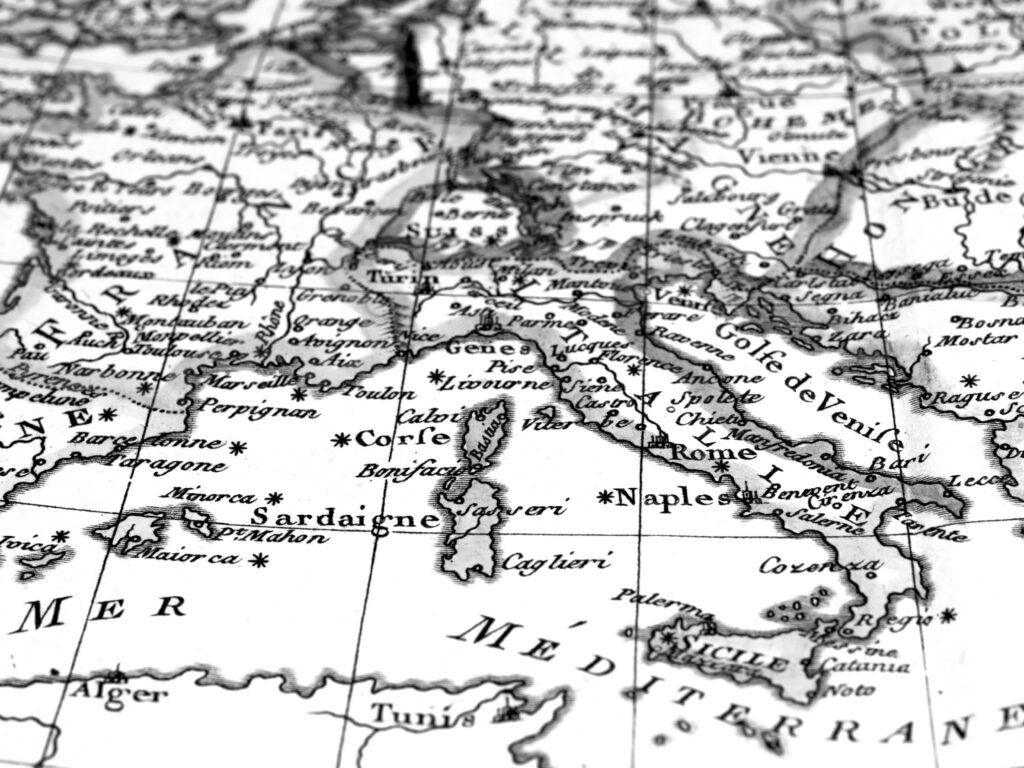It sounds like the title of a fantasy book, but unfortunately, it’s all too real: the plastic island (or Great Pacific Garbage Patch) is an area where plastic and other waste accumulate in the Pacific Ocean.

Let’s be clear, the plastic island is not a real island with defined borders and solid, walkable ground. That’s why it was long thought to be a myth or fake news. To get closer to reality, we must think of it as a large soup of floating debris. Some larger, others microscopic, these remains stay on the surface or in the first meters of the water column, being tossed around by currents and wind.
Having no natural borders, it’s not easy to determine how large the island is: depending on the pollution threshold chosen as a criterion, it ranges from 700,000 km2 to over 10 million km2, i.e., between 0.2% and almost 3% of the entire water-covered surface of our planet. Seems small? 700,000 km2 is over twice the size of our country.
Locating it may not be easy because it changes position and shape due to the seasonal variability of winds and currents. As a general indication, however, the Great Pacific Garbage Patch orbits between 32°N and 145°W. If the search were only virtual, we anticipate that the island escapes the eye of satellites: using services like Google Maps or Google Earth, the plastic island is not visible because 1. the island is not composed of a single stack of garbage but there is open sea between the debris, 2. a part of the waste consists of small fragments, and 3. only a portion of the plastic floats right on the surface.
How Does a Plastic Island Form?
The plastic island originates from debris of various kinds that reach the ocean from river mouths, coasts, or directly from vessels. Some of the waste has a lower density than seawater (especially packaging) and tends to float. Marine currents and wind can transport them over long distances and decades: in 1992, a load of 30,000 plastic ducks went missing in the Pacific Ocean. In the following 25 years, these toys reached beaches worldwide, from Alaska to Australia, to the Atlantic! The Archeoplastic project can pique curiosity, a museum that collects a selection of ancient stranded plastic waste: old bottles from the ’50s or ’60s with obsolete writings and shapes, Moplen caps, and many others. A mix of nostalgia and horror knowing that after all these years, this waste is still around.
However, if they encounter a vortex of marine currents, floating materials tend to get trapped in the rotating motion. Over time, the accumulation of debris leads to the formation of what we call “plastic islands.” Plastic islands are formed by the action of huge slow-rotating whirlpools that gradually accumulate floating plastic debris and other materials. It is estimated that in the Great Pacific Garbage Patch, over 80,000 tons of plastic are accommodated in 1.8 trillion distinct pieces, with concentrations of over 100 kg of material per km2 in the most polluted areas. According to The Ocean Cleanup, over 90% by weight of the material falls into the categories of mega-plastic (objects above 50 cm) and macro-plastic (between 5 and 50 cm), while looking at the number of pieces, 94% of plastic objects fall into the category of micro-plastic (between 0.05 and 0.5 cm). Even if the waste originally has a certain size, once in the water, the action of wind, waves, constant impacts, and UV light has the effect of breaking down the plastic, turning it into increasingly smaller and harder-to-remove residues.
Other Plastic Islands
The Great Pacific Garbage Patch was discovered by chance in 1997 by Captain Charles Moore while sailing with his boat, but as expected, there are plastic islands at the main oceanic vortices. Since then, others have been found:
- Indian Ocean Garbage Patch (2010)
- South Atlantic Garbage Patch (2017)
- North Atlantic Garbage Patch (2009)
- South Pacific Garbage Patch (2011)
- Arctic Garbage Patch: located in the Barente and Greenland seas, it is a phenomenon that is increasing in size due to the reduction of ice cover
And in the Mediterranean Sea?
Also in the Mediterranean Sea, alarming levels of plastic waste are found. Unfortunately, the Mediterranean is particularly vulnerable for various reasons: firstly, it has an almost closed conformation and is surrounded by three continents with a high population. Secondly, the coasts of the Mediterranean have always been characterized by intense coastal activities, such as shipping, industry, and fishing. Finally, the Mediterranean is characterized by strong tourist flows, causing a seasonal and cyclical increase in waste production and discharge into the sea.

Italy is responsible for a share of plastic waste in the Mare Nostrum: a report by WWF estimates that we discharge 53,000 tons of plastic into the Mediterranean every year, of which a small part through rivers (4%), a part from sea activities such as fishing or navigation (18%), and a large share from coastal activities (the remaining 78%).
According to the report The Mediterranean: Mare Plasticum by IUCN, overall, about 200,000 tons of plastic flow into the Mediterranean every year, mostly macro-plastic (94%). The total amount of accumulated plastic so far is around one million tons. Conceptually, the plastic deposit can be divided into five interconnected spaces: plastic lying on the coast, plastic floating on the surface, plastic submerged in the water column, plastic ingested by animals, and plastic deposited on the seabed. Unlike the conclusions of the WWF report, IUCN researchers specifically point to the seabed as the major repository of plastic residues (over 99% of the total) in the form of microplastics in sediments. The idea that floating plastic is only a tiny fraction of what is actually accumulated in the seas is gaining ground among experts, although there are still many unanswered questions.

As in the case of the oceans, the distribution and composition of plastic debris are not homogeneous among different geographical areas of the Mediterranean. This is due to various causes, including the conformation of the coastline, the presence of hotspots (such as coastal cities or the deltas of rivers like the Po or the Tiber), and, of course, the strength and direction of marine currents. Recently, it has been discovered that the Mediterranean also has its (first) plastic island: it forms cyclically between the island of Elba and Corsica, in an area where the arrangement of the seabed and currents favors the accumulation of floating debris. In the past, similar situations have been reported off Corsica, Sardinia, and in Greece near the island of Rhodes.
What are the damages to the ecosystem?
As reported by N. Nurra in Plasticene, it is possible that a bacterial biofilm may form on the surface of debris during their stay at sea, and this layer can even enrich over time with unicellular algae. The phenomenon is well known, in English, it is called bio-fouling, and it also involves the hulls of ships. Unfortunately, the zooplankton community is attracted to these tiny plastic fragments covered by the biofilm and inadvertently ingests them, thus entering them into marine trophic networks. Research has so far shown that all edible species of marine origin are contaminated by microplastics, from shellfish that continuously filter water to swordfish.
The problem is at least twofold: on the one hand, there is the issue of protecting marine flora and fauna: there are studies confirming that animals that have ingested microplastics experience various harmful effects, from reduced reproductive capacity to a false sense of satiety leading to death from starvation. On the other hand, there is a potential issue concerning human health, with possible effects on cellular metabolism if smaller fragments are able to translocate from the intestinal tract to the lymph and circulatory system. This is without even considering the possible presence of toxic additives.
What are the damages to the ecosystem and public health? The question is difficult to answer, and researchers are still working to find confirmation, but it is certain that the damages are immense.
What solutions do we have?
Given the situation, it is necessary to intervene quickly and on various fronts:
Act upstream and reduce the discharge of plastic waste into the sea
- Reduce plastic consumption through prohibitions, taxation, and a change in purchasing habits still oriented towards disposable items. Examples in Italy of political actions in this direction are the CAM or the Plastic Tax (although not yet in force)
- Improve the quantity and quality of plastic material recycling, both to minimize the production of virgin plastic and to reintroduce waste into circulation, removing it from landfills or from the seas in this case
- Change the mentality in waste disposal. Properly disposing of waste is the absolute minimum we can do to respect the environment!
- Research more sustainable, biodegradable, or compostable alternative materials
Act downstream and minimize the harmful effect of already discharged waste
- Continue to monitor and conduct research on the health of our seas
- Promote projects and collective initiatives. An example in Italy is the volunteer organization Plastic Free, founded in 2019 but already present throughout Italy. PlasticFree organizes beautiful plastic collection events in woods, coasts, etc., where literally sleeves need to be rolled up, as well as awareness events in schools
- Recover as much plastic debris as possible from the environment, including seas, coasts, and rivers: an example of these initiatives is The Ocean Cleanup, which is always at work engineering tools to clean up oceanic vortices. In 2023, we can’t wait to see System 03 in action!
What to remember
Plastic islands are not real islands, but they are areas with a high concentration of floating plastic debris and form at the large marine vortices in our oceans. The largest is the Great Pacific Garbage Patch, but others have been discovered in different parts of the globe, from the Arctic Ocean to the Indian Ocean. The Mediterranean Sea is also affected by the problem of plastic presence; indeed, it is particularly vulnerable due to its conformation and the intensity of coastal and maritime activities. Plastic fragments easily enter the marine food web, even reaching humans, generating both an environmental and public health problem.
Additional Information:
Report Fermiamo l’inquinamento da plastica, WWF: here
Report The Mediterranean: Mare plasticum, IUCN (in English): here
Article on The Ocean Cleanup website dedicated to the Great Pacific Garbage Patch (in English): here
Archeoplastica website: here
Article The missing 99%: why can’t we find the vast majority of ocean plastic? (in English): here
TED talk by Captain Charles Moore, discoverer of the Great Pacific Garbage Patch (in English): here
Video of a sea-cleaning operation by The Ocean Cleanup: here


